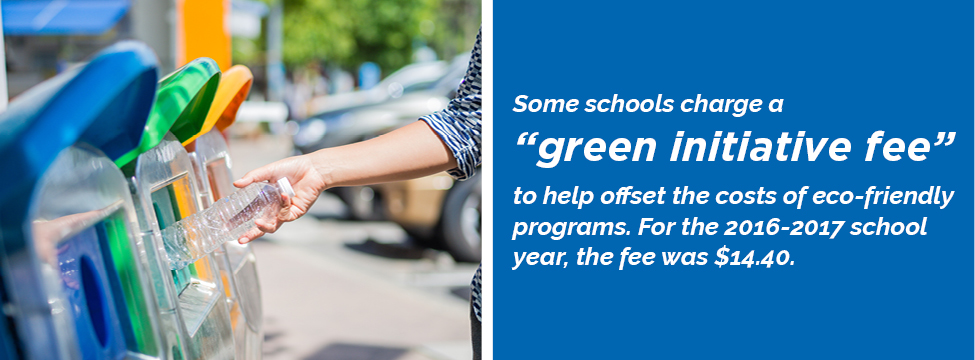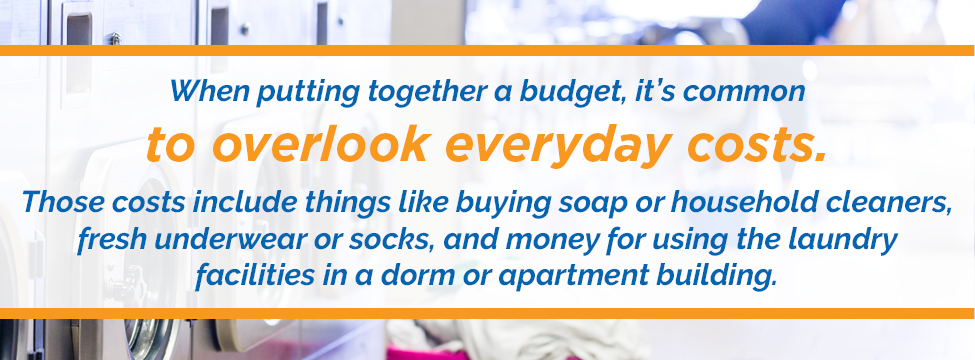How to Calculate the Real Cost of College

There is no getting around the fact that college is expensive. According to the College Board, the cost of tuition at a four-year school for the 2017-2018 school year ranged from $9,970 to $34,740. There are also other fees and expenses connected to a college education that aren’t included in the cost of tuition. Those expenses range from room and board to extracurricular activities, textbooks, transportation to and from school and more.
Knowing what to expect cost-wise when it comes to college can help you make a plan for saving and for paying for your education. It’s also helpful to learn as much as you can about financial aid and other resources available to help students and their families afford the cost of school. Calculate the real cost of college, so that you know exactly what to save and how to create a budget for those four years.
Common College Costs
You can group the costs and expenses associated with college into multiple categories. Keep in mind the costs your school charges and the costs associated with everyday life. Common expenses include:
- Tuition
- School Fees
- Room and Board (dormitory or off-campus housing)
- School supplies
- Textbooks
- Transportation (around school and to/from home)
- Life’s Necessities
- Social life activities
- Extracurricular activities
Let’s take a closer look at the average cost of each category.
Tuition and School Fees
Tuition accounts for the most significant single expense for college students who go to a four-year school and live on campus. Tuition makes up 40%-80% of all college costs, annually.
It’s important to understand that tuition can vary not only based on the type of school you attend, but also by the kind of program you’re enrolled in — some majors cost more than others. That cost difference shouldn’t influence your decision on what you want to study, but it is something to keep in mind when developing a full picture of college expenses.
Another thing worth noting is that what your family pays for tuition might not be the same as the “sticker price” of the school. If you apply for financial aid, what you are responsible for paying is based on your family’s income.
Drexel University, in Philadelphia, has a tuition price of $50,874 for the 2018-2019 academic year. Once you factor in financial aid, the average annual amount families pay is $37,747, according to the U.S. Department of Education. The average yearly cost for families who earn less than $30,000 is $29,355. For families with incomes over $100,000, the average annual cost climbs to $43,972.
Although the listed price of tuition can look very high, don’t let it deter you from applying to a particular school. Financial aid can help to reduce the cost of tuition significantly.
Along with charging tuition, many schools also charge per-semester fees. At some schools, the fees might be included in the final tuition cost. At others, the school might itemize the fees, so that they are each listed separately. Additionally, at some schools, the fees you have to pay vary from year to year.
Some schools charge freshmen students an additional fee to cover the costs of services and support systems to help them adjust to college life. As you approach graduation, your school might automatically charge you a commencement fee the year or semester you expect to graduate.

Other typical fees schools charge include:
- Technology fees: These cover the costs of printers, computer labs and other technological resources offered by the college.
- Lab fees: These are usually for specific courses.
- Eco/”Green” fees: Some schools, such as the University of California, L.A., charge a “green initiative fee” to help offset the costs of eco-friendly programs. For the 2016-2017 school year, the fee was $14.40.
- Campus fees: Some schools lump all their fees together into a general purpose “campus fee.”
- Athletic fees/activity fees: Even if students want to spend the next four years sitting in their dorm rooms, many schools still charge an activity or athletics fee to cover the costs of certain programs.
- Transportation fees: Many colleges offer “free” transportation around campus or shuttle service for students. The service isn’t really “free,” though, because it is added to the tuition bill.
Room and Board
After tuition and fees, room and board is the other major expense a college student faces. Although there’s a considerable range when it comes to tuition cost, room and board costs (for on-campus living) tend to be similar whether a student attends a private, four-year institution or a public, four-year institution. At a public four-year school, room and board was an average of $10,800 per student (either in-state or out-of-state) during the 2017-2018 school year. At private four-year colleges or universities, the average room and board costs were $12,210 during the 2017-2018 school year.
The average cost of room and board for a student who decides to live off-campus during the school year can vary considerably. If a student chooses to live with their parents, the costs are nearly non-existent. But if a student chooses to rent an off-campus apartment, the price often depends on the market rate in the area where the school is located. The median rent for a one-bedroom apartment in Philadelphia ranged from $970 to $1,410 per month. The average cost of a one-bedroom apartment in Harrisburg is $678 per month.
How much a college student spends on food depends in part on how much they eat and the types of food they eat. Ordering take-out or delivery adds up quickly and costs considerably more than purchasing groceries at the supermarket. Fun fact: During the four years of study, the average college student typically spends $2,000 on pizza alone. Students who decide to consume alcohol during their college years spend around $500 annually on beers, wines and other beverages.
Books and School Supplies

Textbooks and school supplies make up a smaller percentage of a college student’s budget compared to tuition and room and board. The average student spends between $1,000 and $1,500 on books and supplies each year.
There’s a considerable amount of range when it comes to the cost of books and supplies, depending in part on what a student studies. Some textbooks cost more than others, although the average price for a new textbook was $80 in the 2015-2016 school year. Some majors are also more supply-heavy than others. Art students typically need to pay for supplies such as sketchbooks, canvases, paints and pencils, but they may not need as many textbooks.
Many students also need to purchase laptops or other equipment to help them study. Although most universities and colleges offer computers for student use, students often find it more convenient to have their own gear for use in class and when studying.
The good news about textbooks and school supplies is that there is often a way to get them at a reduced cost. Unless a course requires the most recently published edition of a textbook, it’s usually possible to find a used version for a lower cost. The average used textbook costs $51, a savings of 37% over new. Students can also consider sharing books with their classmates. In some cases, it’s possible to find the book you need for school at your local or university library, meaning you can use it for free.
Secondhand supplies, such as gently used laptops or other electronics, are also often available for a reduced price.
Transportation
Unless you plan on spending every single day of every semester on-campus, you’re going to have some transportation expenses. Transportation costs vary based on whether you’re an on-campus student or a commuter student. They can also change based on whether you have a car and how far away from your family’s home the school is.
If your school lets on-campus students bring their cars to school, you might need to pay for parking in the campus lots. Schools that charge for parking often base their rates on a student’s residency status. A Boston University parking permit costs under $300 per year for commuting students who attend evening classes. Day students who commute need to pay more than $1,000 per year. Students who need overnight parking can pay anywhere from $1,432 to $1,961 per year.
Another thing to consider if you’re going to drive to campus or bring your car to college is the cost of gasoline and maintenance, including inspections and oil changes on a regular basis.
Even students who decide to go car-free for college can expect to face some transportation expenses. The total cost depends on the public transit options in the area near the university or college and how frequently a student needs to use transit.
Traveling Home
One component of the cost of transportation that students often overlook is the cost of getting home for the holidays. When a student attends a college near their family’s home, it can cost just a few dollars to get back. But when a student decides to go to college a few states away, it might be necessary to buy a plane ticket home for holidays. Given that the holiday season is often a pricier time for flying, those costs can add up.
Life’s Necessities

When putting together a college budget, it’s common to overlook everyday costs or “life’s necessities.” Those costs include things like buying soap or household cleaners, fresh underwear or socks, and money for using the laundry facilities in a dorm or apartment building. A few other everyday necessities that often get overlooked include:
- Cell phone/smartphone bill
- Internet or cable bill
- Coffee/tea
- Snacks
- Personal care products
- Medicines (both over-the-counter and prescription)
- Toilet paper and other paper products (usually not needed if the dorm has shared bathroom facilities)
- Clothing
- Bedding
- Dorm or apartment furnishings
- Shoes
- Birthday/holiday gifts
The average college consumers spend anywhere from $106 on apartment/dorm furnishings to $81 on shoes during the academic year. Of course, there are ways to cut down on spending on some types of necessities. You can buy personal care products in bulk or bring bedding from home rather than buying a new set.
Social Life and Extracurricular Activities
Although college students are masters at finding ways to have fun on the cheap, being social or participating in extracurricular activities can come with a price tag. Students who are interested in joining a fraternity or sorority might pay anywhere from a few hundred dollars to more than $1,000 per semester for the privilege of participating in Greek life.
Other clubs and activities at school can also have a price tag. Clubs often charge dues or expect their members to purchase specialized equipment or clothing. Some clubs hold special events, such as dances or parties and expect their members to chip in to defray the cost of those programs.
Getting Help Paying for College
Considering the total costs associated with college can be overwhelming — but, fear not! There is a plethora of options to help reduce or finance the cost of a post-secondary education. Your financial aid options include:
- Grants: Grants do not need to be repaid. There are grant programs from the federal government and often at the state level as well.
- Institutional scholarships: Scholarships do not need to be repaid. Your school or program may offer scholarships based on academic performance, athletic ability or other criteria.
- Private scholarships: Many companies also have scholarship programs available to help college students.
- Federal student loans: Loans of any kind do have to be repaid. Federal student loans have flexible payment plans, often based on income.
- Private student loans: These are more traditional loans from private lending institutions like banks. Private loan repayment plans vary by the loan originator.
Student Loan Interest

If you have student loans, it’s worth considering the cost of loan interest, both when you are in school and after graduation. The interest rate charged on a loan can increase the cost of school, but there are ways to keep interest rates from adding up.
Although certain student loan interest programs don’t require you to make interest payments while you are still a student, in some instances, it can be worth incorporating the cost of interest into your college budget. If a student loan is unsubsidized or is a private loan, the interest that accrues while you’re still in school gets capitalized or added to the principal balance when you graduate. That means your interest can end up earning interest, adding to the overall cost of your loan.
Saving for College
Along with applying for financial aid when it’s time to attend college, you can also make a plan to start saving for school now. If you live in Pennsylvania, learn more about the free savings accounts Mid Penn Bank offers.
When deciding where to go to school, look carefully at the tuition price, additional costs and the amount of financial aid you receive from each institution. It could be that the school with a higher sticker price ends up costing you less out of pocket once you take financial aid options into account. It’s also a good idea to make a budget for each year of school so that you have a clear understanding of what your expenses are and how you will cover those costs.
Share:
Disclosures
The material on this site was created for educational purposes. It is not intended to be and should not be treated as legal, tax, investment, accounting, or other professional advice.
Securities and Insurance Products:
NOT A DEPOSIT | NOT FDIC INSURED | NOT BANK GUARANTEED | NOT INSURED BY ANY FEDERAL GOVERNMENT AGENCY | MAY LOSE VALUE
